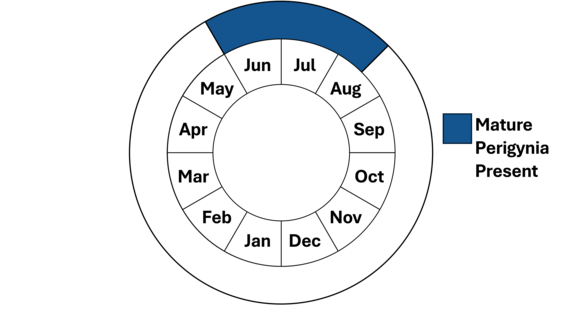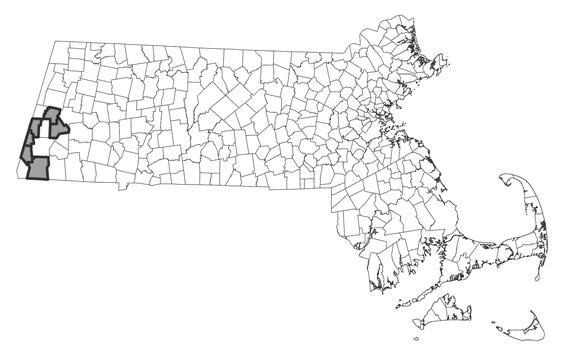- Scientific name: Carex tetanica
- Species of Greatest Conservation Need (MA State Wildlife Action Plan)
- Special Concern (MA Endangered Species Act)
Description
Fen sedge (Carex tetanica), a member of the sedge family (Cyperaceae), is a perennial, herbaceous, grass-like plant of calcareous meadows and fens. It is a slender plant between 1.2-6 dm (~5 in to 2 ft) in height. Its vegetative shoots are loosely scattered and arise from long, underground stems, called “rhizomes.” To positively identify the fen sedge and other members of the genus Carex, a technical manual should be consulted.
The fen sedge is fairly distinctive because of its two-toned pistillate scales (purplish-brown margins and green centers), the absence of slender prolonged tips known as “beaks” on the perigynia, and two prominent lateral perigynia ribs. Achenes are trigonous (three-sided). The uppermost spike bears only staminate flowers, while the one to three lower spikes bear only pistillate flowers. The spikes of flowers are long-cylindric and well-separated. At least the lowest spike is on a long, slender stalk. The bracts, or leaf-like structures found below the flower spikes, are long and leaf-like.
One sedge of fen habitat that resembles the fen sedge early in the season is the golden sedge (Carex aurea), but that sedge may be distinguished by the presence of two stigmas (compared to three in the fen sedge) with more glaucous-white perigynia in the early summer. Another sedge of fens that could be confused with the fen sedge in Massachusetts is the Endangered glaucous sedge (Carex livida); however, its leaves are narrower, inrolled or channeled, leathery in texture, and pale in color. The millet sedge (Carex panicea) is an introduced species of meadows in our region; however, it usually grows in drier conditions than the fen sedge. The millet sedge can be distinguished by its smooth texture at the top of the stem (rough in the fen sedge) and by the rounded base of its achenes (tapered to the base in fen sedge).
Life cycle and behavior

Species in this genus have tiny, wind-pollinated flowers that are borne in spikes. Each flower is unisexual and closely subtended by small, flat scales that largely conceal the flowers. The staminate (i.e., pollen-bearing) flowers are subtended by a single scale. The pistillate (i.e., ovule-bearing) flowers are subtended by two scales, an outer flat scale (pistillate scale) and an inner, sac-like scale, called a “perigynium”, that encloses the flower and, later, the fruit.
Population status
Fen sedge is listed as special concern under the Massachusetts Endangered Species Act. All listed species are protected from killing, collecting, possessing, or sale and from activities that would destroy habitat and thus directly or indirectly cause mortality or disrupt critical behaviors. Fen sedge is, in part, rare in the state because of the scarcity of suitable habitat. The calcareous fens in which fen sedge grows occur primarily in western Massachusetts. There are five populations of fen sedge that have been verified since 1999; an additional 14 populations have not been recently observed. Recent observations have all been in Berkshire county.
Distribution and abundance
The documented range of fen sedge extends from Massachusetts to Virginia and westward, across the northern Midwest to Saskatchewan and as far west as the Dakotas, Kansas and Arkansas. In New England, fen sedge is not known in Maine or Vermont and is presumed extirpated from New Hampshire. It is considered imperiled in Massachusetts, vulnerable in Connecticut, and hasn't been assessed in Rhode Island.

Distribution in Massachusetts
1999-2024
Based on records in the Natural Heritage Database
Habitat
In Massachusetts, the fen sedge grows primarily in open, wet fens and meadows where there is calcareous groundwater seepage. It also occurs in openings within large calcareous seepage swamps. The fen sedge typically grows in association with other sedges and herbs. Associated sedges include yellow sedge (C. flava), porcupine sedge (C. hystericina), delicate sedge (C. leptalea), yellow fox-sedge (C. annectens), and inland prickly sedge (C. interior).
Associated herb and grass species are grass-of-parnassus (Parnassia glauca), marsh muhly (Muhlenbergia glomerata), Robin’s plantain (Erigeron pulchellus), tall meadow-rue (Thalictrum pubescens), and invasive weeds like purple loosestrife (Lythrum salicaria). Shrubby cinquefoil (Dasiphora floribunda), hoary willow (Salix candida), and autumn willow (Salix serissima) are associated shrub species. The fen communities in which fen sedge occurs often contain other state-protected rare plant species, including dioecious sedge (Carex sterilis, threatened) and capillary beak-sedge (Rhynchospora capillacea, endangered).
Healthy habitats are vital for supporting native wildlife and plants. Explore habitats and learn about conservation and restoration in Massachusetts.
Threats
Several of the known populations in Massachusetts are kept open by mowing or grazing, which prevents succession to shrubs and trees. However, over-mowing or over-grazing may threaten the populations. At one site, it was noted that plants were being trampled by excessive grazing. More information is needed to determine what level of grazing is appropriate. In addition to maintaining an open habitat, it is necessary to maintain the natural hydrologic regime of the natural community.
Conservation and management
As for many rare species, exact needs for management of fen sedge are not known. The following comments are based mainly on observations of Massachusetts populations. Fen sedge prefers open habitats and full sun. Annual mowing seems to be best suited for maintaining an open habitat without damaging the existing plant population.
Contact
| Date published: | April 9, 2025 |
|---|